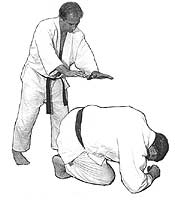The Combat Roll

by Prof. Gene Roos, 9th dan Jujitsu, 4th dan Judo
Recently, after being distracted, my foot slipped off the cement sidewalk
and I felt extreme pressure on my ankle. In order not to break or sprain
the ankle, I did a combat roll on part of the cement and grass with no
injury. The combat roll is not pretty. In fact to many the combat roll
looks like a crude adaptation of the rolls they have long been taught.
In my experience, however, it might just save you from serious injury.
For over 46 years I have done Jujitsu, Judo and Aikido rolls. However,
the combat roll for me has its own unique advantage. It allows you to
minimize injury if you fall, slip or are pushed directly down (forward)
on a hard surface. It also provides you the opportunity to roll and/or
counterattack when you do not have the time or luxury of thought. In the
sequence shown below I demonstrate this roll after having been pushed
from behind.
Judo and aikido rolls are somewhat different. They help the person falling
roll out of an armbar projection, cork screw, throw or certain wrist locks
(sankajo, yonkyu, etc.). In aikido, for example, the roll is usually an
elliptical fall rather than circular. Elliptical falling causes your body
to speed up and hit the surface at a different angle. But, because they
generate substantial centrifugal forces, the faller's ankles can sustain
damage or pain when hitting a hard surface.
Modified judo and aikido rolls (no slapping), and just contacting the
bottom of your feet and shoulders, result in high pressure contacts. On
hard surfaces, this could cause injury to the feet, shoulders and the
small of the back.
Another often-taught technique in judo and jujitsu is just to fall forward
(without a roll) to absorb the fall on your hands, forearms and toes.
On hard surfaces this can also cause injury.
While these techniques might work for some, I prefer the combat roll when
the direction of the fall is directly downward. When using the combat
roll, your downward energy is compacted and the tight roll causes a slight
flowing impact.
One arm (two optional) also protects your head, and by curling into a
small circle, you become a small ball close to the hard surface. Thus,
centrifugal force on the ankles is minimal. Your hand (palm) is facing
the ground to give more support (the arm and elbow are locked). If your
palm is facing your head, it is weaker and the elbow may give way or bend,
causing your head to contact the cement.
The purpose of the arm is to protect your face or head from contacting
or hitting the cement. Since you have controlled your fall downward with
your leg or legs, your arm should end up near the ground and is only about
six inches away from your forehead to provide a safety or give factor.
You will roll in a circle over your head, to the flat of the back (not
the shoulder), the hips to the bottom of your feet and up to a standing
position.
I know the combat roll is very different from what most aikido, judo and
jujutsu practitioners have been taught, but don't reject it outright.
Try it and you will see that is a viable alternative in situations where
you find yourself falling directly downward.
Acknowledgement:
This article is an edited and enhanced version of one
first printed in the American Jujitsu Association's Newsletter, Fall 2001.
About The Author:
Prof. Gene Roos, 9th dan Ju Jitsu, and 4th dan in judo, is a member
of the Board of Directors for the America Ju Jitsu Association. In 1958
was awarded Shodan (Judo) and won the Regional Judo Champion. In 1958
& 1959 was Judo State Champion. His instructors include: Harold
Brosious (Ketsugo), Dennis Palumbo (Hakko Ryu Ju Jitsu, 8th Dan), George
Kirby, & Shizuya Sato (Ju Jitsu), Wally Jay (Small Circle Ju Jitsu),
Dr. Sacharnoski (Hard Style Ju Jitsu & Ki) and Master Mochizuki
(a student of Funakoshi, Kano, & Ueshiba). He is also the author
of a series of upcoming books on Aiki jujitsu as well as a number of
videos including: "Aiki Jujitsu" (a three video tapes series
with manuals); "Deadly Attacks" (defense against 30 knife,
gun, stick and empty hand attacks); "Deadly Attacks- part II"(defense
against an additional 30 knife, gun and empty hand attacks); "Deadly
Attacks III" and "Devastating Throws and Other Deadly Attacks
" (defense against 30 advanced combat throws, knife attacks, stick,
and a rear shotgun attack), For more information see:
http://www.aikijujitsu.homestead.com/aikijujitsu.html
|